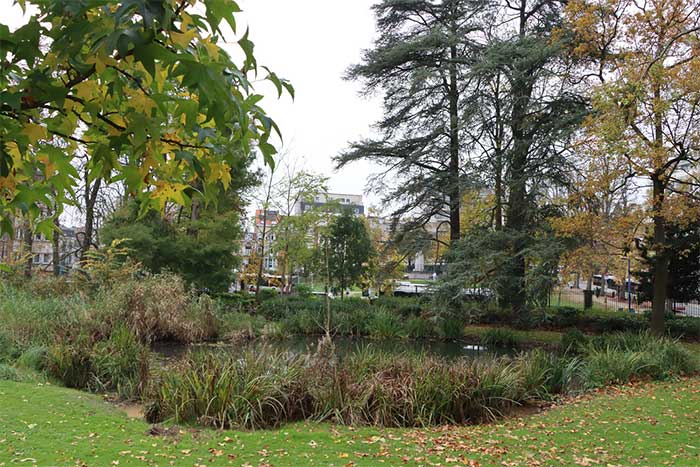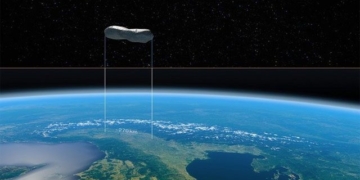History shows that humans have the ability to adapt to harsh conditions, but to cope with the future of a warming climate, collaborative and creative solutions are needed, especially in agriculture and water resource management, to ensure the survival of both humanity and ecosystems.
Transforming urban areas into livable spaces amidst climate change is a challenging task for many modern cities. Experts point out that, compared to rural areas, cities are more vulnerable to rising temperatures. Impermeable road systems, dense building structures, and dark colors allow urban areas to absorb heat throughout the day and release it at night, causing the “heat island effect.” In Brussels, a study found that during summer, temperatures in the city center are on average 3°C higher than in the surrounding countryside. At night, the temperature difference can reach up to 8-9°C under certain conditions.

The streets of Brussels are designed with green spaces.
In response to this challenge, experts assert that it is necessary to “redesign” cities from the ground up – minimizing impermeable materials, increasing greenery and natural soil to make urban environments more similar to rural climates. This is not an easy task, especially in the Brussels area, where 53% of the land is impermeable, and this figure reaches 93% in the city center. Since 1955, the area has seen its impermeable surfaces double.
To envision what future cities might look like, Dries Street in the Forest district serves as an example. Located in a poorly developed residential area, the street has been completely renovated with a “urban jungle” appearance, distinct from the surrounding roads. Instead of small tree pits, there are rain gardens spanning one or two parking spaces, filled with diverse greenery. Rainwater is given time to soak into the ground rather than quickly draining away, replenishing groundwater and creating an ideal environment for plant growth. At the end of the street, a small square is entirely green, featuring a cherry tree and a fountain, creating a sense that the path must weave through the trees to create a passage.
These urban rain gardens are not merely green landscapes but also provide dual benefits for the environment and climate. During heavy rains, rain gardens help retain water, alleviating pressure on drainage systems that are prone to overload. On hot days, the greenery in the rain gardens cools the air by providing shade and promoting evapotranspiration from the plants. “Greenery acts like a natural air conditioner,” explains urban architect Gery Leloutre, a lecturer at the Université Libre de Bruxelles (ULB). He adds, “When you enter a forest, you can immediately feel the coolness. What we want to recreate here is these ‘mini forests’ in the heart of the city.”
According to Mr. Leloutre, these changes do not require large investments, which is encouraging. “This type of renovation is entirely within the financial reach of every locality. We just need to remove about ten parking spaces in exchange for positive climate and social benefits for residents.” However, not everyone is easily accepting of reduced parking spaces. Public space is limited, making conflicts over usage needs unavoidable. Nevertheless, Mr. Leloutre believes this is an inevitable path: “If we want to cool down the city, we must reduce concrete usage and rebalance public space.”
Mr. Julien Ruelle, head of the natural development department at the Brussels Environment Department, also emphasizes the need for the city to make clear priority decisions. “Green solutions can only create local impacts. To achieve widespread effectiveness, we need to replicate this model across various areas to create a green and blue network – an ecosystem comprising interconnected green spaces and water resources.”

Rain gardens, an effective solution for the environment and climate.
Restoring Urban Rivers
Restoring forgotten rivers back into public spaces is not just an action to beautify urban areas but also a way to improve the environment and connect people with nature. The Senne River in Brussels is a prime example. Once, this river flowed through a lush wetland, serving as the city’s green lung. However, since the 18th century, to facilitate urbanization, humans have gradually “suffocated” the Senne by filling in ponds and turning pristine rivers into polluted drainage ditches. Furthermore, the construction of transportation infrastructure like roads and railways has fragmented the natural flow, completely disrupting the hydrological ecosystem.
Currently, one of Brussels’ prominent projects aimed at adapting to climate change is the reopening of a 650-meter stretch of the Senne River, from Sainctelette to the Vergote basin (the Max-sur-Zenne project). This project not only helps restore a river but also creates connections between natural areas, enhancing ecosystem resilience. Mr. Julien Ruelle believes that isolated areas are highly vulnerable. For nature to benefit humans, it is essential to support nature in its recovery and resilience.
So how does restoring these rivers affect environmental temperatures? Mr. François Mayer, project manager at Brussels Environment, notes: When water flows, it cools the temperature, but this effect is only local. In addition to cooling from water, the “corridor” wind effect also plays an important role. “The area around the canal in Brussels is cooler than other areas, not because of the water, but due to the breezes created by that space.” he further explains.
However, reopening rivers is not easy, as urban development increasingly restricts spaces for rivers. The project also requires the renovation of surrounding areas, increasing costs. This is one of the challenges the Max-sur-Zenne project faces, as the nearby Maximilien park also needs complete renovation. With rising costs and limited budgets, the project is currently being adjusted.
Moreover, reopening rivers must also address the issue of ensuring adequate water supply. Rivers have been separated from their natural watersheds, while rainwater now flows directly into the drainage system. As a result, river flow is often very weak. This necessitates restoring connections to natural water sources, which not only requires effort but also boosts environmental water restoration projects in Brussels.
Fountains, Misting Machines, and Public Swimming Pools
In the effort to cool urban spaces, devices such as fountains and misting machines are being implemented to provide immediate cooling sensations. When water droplets come into contact with air and sunlight, they evaporate quickly, creating a significant cooling effect. However, this solution still presents many issues to consider.
“They require regular maintenance and raise concerns about water consumption during drought periods,” Mr. Julien Ruelle notes. According to him, while this solution may suit highly urbanized areas, it does not address the fundamental issue: “the concretization of the environment. More systematic solutions, such as urban greening, remain a priority.” However, installing drinking fountains helps meet another essential need, providing public drinking points during heatwaves. Districts like Ixelles and Schaerbeek in Brussels have created maps of “cool islands” to help residents easily locate cooling spots in the city.
Additionally, cities are also focusing on creating public swimming areas to help residents cool off during hot days. In Brussels, an outdoor swimming pool opens during the summer along the canal in Anderlecht. Moreover, a project to renovate Neerpede Pond in Anderlecht into a public swimming area is also being planned. Adapting to climate change and cooling urban areas is a process that requires time and patience.

Brussels has many green spaces.
Climate Adaptation: A Long-Term Challenge for Humans and Ecosystems
In the context of rapid climate change, paleoclimatologist Louis François from the University of Liège shared insights about Earth’s climatic past and the significant challenges for the future. He noted that over the past 10,000 years, the Earth has not experienced a temperature increase as strong as the current one. Throughout the glacial period, a stable climate allowed civilizations to develop. However, he believes that looking back further, particularly a few million years ago, the Earth was warmer and faced harsher climatic conditions.
Mr. Louis François pointed out that during the Pliocene epoch, approximately 4 to 5 million years ago, the Earth’s climate was warmer than it is today—somewhat similar to forecasts for the year 2100. In fact, during the Miocene, around 15 million years ago, Europe was home to subtropical forests and various species of crocodiles. Climate forecasts for the end of this century may bring temperatures back to such levels, but the ecosystems will not be identical due to many differing environmental conditions.
Mr. Louis François further noted that after the last Ice Age around 10,000 years ago, as temperatures began to rise, the vegetation in Europe took several thousand years to recover and resettle from southern European regions. Although this was not a rapid process, on a geological time scale, the recovery occurred quickly enough for ecosystems to self-balance.
Regarding human impact, Louis François explained that since the Neolithic period, about 10,000 years ago, humans have begun to influence the climate through agricultural activities. Widespread deforestation has altered local climates and may have affected the global climate, even slowing the natural decline of CO₂ that began around 8,000 years ago. However, the current rate of warming has been significantly recorded since the Industrial Revolution around 1800.
Looking to the future, Mr. François warned that extreme weather events will be the greatest challenge for humanity and ecosystems. Even though global average temperatures are predicted to rise by only a few degrees Celsius by 2100, extreme phenomena such as heatwaves and droughts are becoming increasingly severe. The rate of warming in high-latitude areas is faster than in tropical regions, exacerbating drought conditions in many places.
He also emphasized that the past teaches us valuable lessons about the Earth’s ability to adapt to climate fluctuations. However, he cautioned that the current rate of climate change is unprecedented, requiring rapid adaptation efforts from ecosystems. History shows that humans have the capacity to adapt to harsh conditions, but in order to cope with the warming climate in the future, Mr. Louis François believes collaborative and innovative solutions are necessary, particularly in agriculture and water management, to ensure the survival of both humanity and ecosystems.



















































